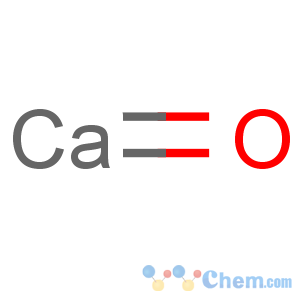Title: Calcium Oxide
CAS Registry Number: 1305-78-8
Synonyms: Lime; burnt lime; calx; quicklime
Molecular Formula: CaO
Molecular Weight: 56.08
Percent Composition: Ca 71.47%, O 28.53%
Literature References: Properly stored lime of commerce contains 90-95% free CaO. Commercial production from limestone: W. L. Faith
et al., Industrial Chemicals (John Wiley, New York, 3rd ed., 1965) pp 482-487. Lab prepn by ignition of CaCO3: Ehrlich in
Handbook of Preparative Inorganic Chemistry vol. 1, G. Brauer, Ed. (Academic Press, New York, 2nd ed., 1963) p 931.
Review: R. S. Boynton in
Kirk-Othmer Encyclopedia of Chemical Technology vol. 14 (Wiley-Interscience, New York, 3rd ed., 1981) pp 343-382.
Properties: Crystals, white or grayish-white lumps, or granular powder; commercial material sometimes has a yellowish or brownish tint, due to iron. mp 2572°; bp 2850°; d 3.32-3.35. Readily absorbs CO2 and H2O from air, becoming air-slaked. Sol in water forming Ca(OH)2 and generating a large quantity of heat; sol in acids, glycerol, sugar soln; practically insol in alc.
Keep tightly closed and dry.
Melting point: mp 2572°
Boiling point: bp 2850°
Density: d 3.32-3.35
CAUTION: Potential symptoms of overexposure are irritation of eyes, skin, upper respiratory tract; ulceration or perforation of nasal septum; pneumonia; dermatitis.
See NIOSH Pocket Guide to Chemical Hazards (DHHS/NIOSH 97-140, 1997) p 48.
Use: In bricks, plaster, mortar, stucco and other building and construction materials; manuf of steel, aluminum, magnesium, and flotation of non-ferrous ores; manuf of glass, paper, Na2CO3 (Solvay process), Ca salts and many other industrial chemicals; dehairing hides; clarification of cane and beet sugar juices; in fungicides, insecticides, drilling fluids, lubricants; water and sewage treatment; in laboratory to absorb CO2 (the combination with NaOH is known as soda-lime,
q.v.).

